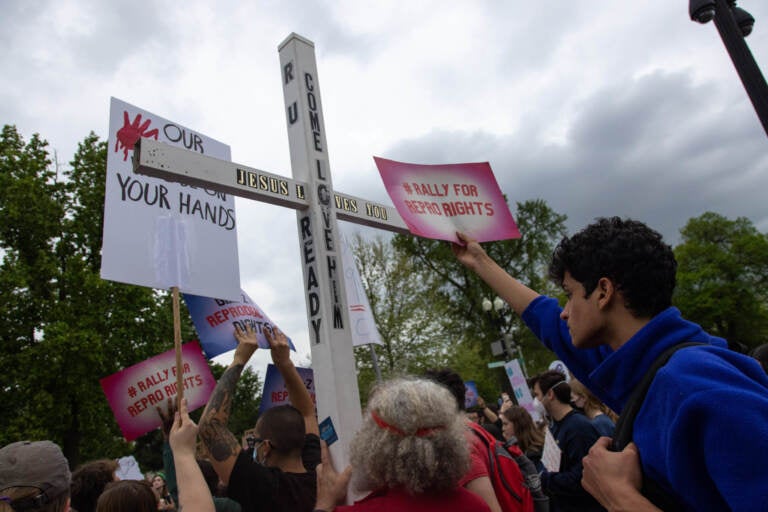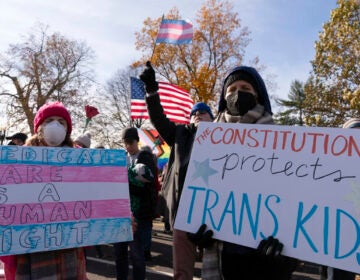The leaked abortion decision blew up overnight. In 1973, Roe had a longer fuse

A counter-protestor holds a large cross during a youth pro-abortion rights rally outside of the Supreme Court in Washington, D.C., on May 5, following the leak of a draft Supreme Court opinion to overturn Roe v. Wade. (Anadolu Agency via Getty Images via NPR)
The U.S. Supreme Court’s apparently imminent decision to overturn its landmark Roe v. Wade ruling on abortion rights has dominated the news as few other stories ever have.
Even in a week of riveting stories erupting from the Ukraine to the Federal Reserve, the nation’s media devoted themselves to abortion. No type was too big, no broadcast intro too hot. Cue the thunder and lightning. This was news.
It would have been impossible to imagine all this when the Roe ruling came out in 1973. In fact, it’s hard to believe today how little appreciation there was at the time for the decision’s eventual impact and importance.
Yet it is no exaggeration to say that since Roe, American politics have never been the same.
In the 1960s, abortion had gone from being a whisper in private to a topic for heated public argument. But it was Roe that would transform that issue into a political force that has only grown since.
What had been presumptions of American politics for a century – the partisan alignment of Catholics and Protestants, the dominant parties in the North and the South – would be radically altered. Many a star would fall from high office, and many new stars would be born.
The reaction to Roe was immense, but not immediately so. It took months and years for the anti-abortion movement to fully form, to organize and gain political power – first in state legislatures and in Congress.
Along the way, the movement helped elect four Republican presidents who would in turn appoint all of the Supreme Court justices now expected to overturn Roe. Each is a member of the conservative Federalist Society, which began in law schools in the years after Roe. It has flourished, eventually producing hundreds of federal judges, most of those currently serving appointed in the one term of former President Trump.
Today, observers tend to agree that this impending decision about Roe, like the one in 1973, has the potential to energize millions who have not been as politically active. But we can only speculate as to what that will mean.
America could not foresee all the ramifications of Roe then. Do we think we can see the future more clearly now?
At first, there was a muted response to Roe
We usually look to the past as some sort of guide. But in this case, looking back mostly reminds us of how much certain things have changed.
In January 1973, a reporter at Time magazine got wind of the Roe decision in a message from a Supreme Court clerk who thought he was just offering background guidance ahead of the release.
The announcement was delayed, and Time had to sit on the news for a week until its next edition appeared on newsstands (a perfect symbol of old school). This time around, Politico shared the leak online late Monday and it was everywhere around the world within minutes.
Back in 1973, Chief Justice Warren Burger had reportedly held back the Roe release to avoid distracting from that week’s inaugural festivities as President Richard Nixon began his second term. Still, Burger did not expect the decision to be all that disruptive or have the “consequences” predicted by the dissenting justices. “Plainly,” he wrote in his own concurrence with the Jan. 22 decision, “the Court today rejects any claim that the Constitution requires abortion on demand.”
Abortion opponents nonetheless saw it as such. The U.S. Conference of Catholic Bishops condemned it immediately and began its long campaign against it.
But the issue was not on everyone’s mind that winter. The cases that had reached the Supreme Court in that session had been in the news but were scarcely household names. Nixon’s chief of staff did not mention the ruling in his diary for Jan. 22, distracted by preparations for a Vietnam peace deal announcement and the news that former President Lyndon Johnson had died that same day.
Johnson’s death was the dominating headline story in The New York Times the next day, with a double-deck headline across the eight-column format and a formal portrait. Roe was a second lead in lesser type.
Roe had been the lead story the night before on CBS Evening News with Walter Cronkite. The venerable anchor read a short intro calling it “a landmark ruling” and adding that the abortion laws of 46 states had been “rendered unconstitutional.”
Cronkite tossed to reporter George Herman, who summed up the ruling as the camera panned over an artist’s drawing of the nine justices. Herman said the White House had declined to comment but that Nixon had always been opposed to legalized abortion. The report was less than three-and-a-half minutes.
Nixon had brought up the decision in a chat with aides that evening — captured by an automatic taping system — but without much heat. On the tape he can be heard to say “there are times when abortions are necessary, I know that … you know … between a Black and a white.”
When an aide added: “Or rape.” Nixon agreed: “Or rape … you know what I mean. There are times.”
Biographer John Farrell has written that Nixon told his team not to emphasize issues such as abortion. He quotes one policy aide saying that for Nixon, those issues “weren’t even on the table.”
Other issues topped the minds of voters in the midterm elections in 1974
For most American news consumers, Roe was soon buried beneath other preoccupations. The winding down of the Vietnam War was soon be eclipsed by news of a scandal left over from the 1972 campaign. Burglars who had broken into the Democratic national headquarters in the Washington’s Watergate office complex were paid hush money that would be traced back to the Nixon campaign.
The White House involvement would be slowly, painfully exposed – with the ultimate evidence coming from White House tapes. Hearings in the Senate were followed by dramatic firings and resignations, impeachment hearings in the House and Nixon’s resignation in August 1974.
Meanwhile, the Yom Kippur War in the Middle East had led to the Arab oil embargo and quadrupled the price of oil — and the price at the gas pump – fueling inflation that would continue for a decade. By the time voters got to the polls for the midterms of 1974, abortion was far from uppermost on most minds.
In 1976, the Democratic Party nominated Jimmy Carter, who was personally opposed to abortion but also opposed a constitutional amendment to overturn Roe. The Republican Party nominated incumbent President Gerald Ford, who opposed abortion and supported a constitutional amendment, although his wife and vice president were known to see the issue differently.
Both parties’ platforms then acknowledged with respect the division of opinion within their own ranks, though the platforms diverged on the need for a constitutional amendment. Once elected, Carter installed an anti-abortion Catholic as his secretary of Health and Human Services.
Carter’s years in office were a time of conservative pushback in the country on a number of fronts, from tax policy to school desegregation. In an early sign of its rising power, the anti-abortion movement amassed votes in both parties in Congress to approve the Hyde Amendment, banning the use of federal funding to pay for abortions. Hyde has been renewed ever since, despite efforts under Democratic majorities to repeal it.
Another watershed for the anti-abortion movement was the rise of Ronald Reagan, who had the support of many social conservatives when he challenged Ford for the nomination in 1976. By the time the 1980 nominating contest arrived, Reagan was ascendant. He won the South Carolina primary, dominated by evangelical white voters. Many of these were recent converts to Republicanism drawn to Reagan, following the lead of some of their favorite TV preachers such as Jerry Falwell.
Reagan was able to sound less harsh about abortion, while still stressing the need for a constitutional amendment to overturn Roe. In office, Reagan would focus on national security, cutting taxes and restraining federal spending. Lou Dobbs, a reporter who followed Reagan’s career closely for 30 years, has written: “While I do not doubt Reagan’s sincerity in advocating an anti-abortion amendment, he invested few political resources toward attaining this goal and it was not a high priority of those close to him.”
Nonetheless, Reagan’s reelection platform 1984 had the strongest anti-abortion plank to date, and that posture has remained in place since.
Trump upended the established pattern on abortion messaging
Thereafter, both parties’ presidential candidates tried to placate passionate advocates (on one side or the other) while reassuring swing voters there would be no sudden moves. Bill Clinton, for example. had success with saying abortion should be “safe, legal and rare.”
And while Barack Obama and the two Republicans he defeated in 2008 and 2012 stuck with their respective parties’ usual postures on the issue, abortion was not salient in either campaign.
Then along came Trump, who upended this equilibrium as he did so many others. As a former Democrat known for being supportive of abortion rights, he seemed an unlikely champion for anti-Roe activists. But he was able to convince many, if not all, that his conversion on the issue was genuine.
More important, he convinced them he would appoint Supreme Court justices who would overturn Roe. This was a key when he, like Reagan, broke from the GOP candidate pack in his first South Carolina primary, which by 2016 was even more dominated by social conservatives than it had been in Reagan’s day.
And unlike others, Trump continued to accentuate the issue in the fall campaign – describing the abortion procedure in lurid terms and saying women who had abortions “should face some sort of punishment.” While most Americans might have found Trump’s language repugnant, it caught attention and signposted once again Trump’s promise regarding Roe and the courts.
Democrats, for their part, have doubled down repeatedly on the side of abortion rights, linking them to their support of “human rights” and of groups whose rights had been long suppressed – African Americans and other minority groups, women seeking to vote and enjoy full property rights, LGBTQ people and immigrants.
Republicans at all levels have often seen the Democrats’ devotion to these causes as an opportunity. They have been able to appeal to previously Democratic voters who still had strong allegiance to traditional, often religious cultural and social values. This appeal has been especially potent in rural America and smaller communities beyond the metropolitan areas.
Republicans have gained ground especially among white Catholics and Southerners
Catholics had been a Democratic bloc from their first emergence as a political force in the mid-1800s to the 1960s. As part of the New Deal coalition, they gave the party the lion’s share of their votes.
But that began to change after 1964, as the Democratic Party changed. And it accelerated in the 1970s after Roe. Today, Catholics overall are split almost evenly in party loyalty. But white Catholics tend to be Republican. Polling has shown about 6 in 10 Catholics voted for Trump in 2016 and 2020.
Trump did even better than that among white Protestants who identify themselves as evangelical, a somewhat loose designation that separates them from the “mainline” Protestant denominations. Evangelicals are particularly important as an electoral force in the South, where the partisan transformation of the last half-century has been most pronounced.
Southern whites, especially in rural areas and small towns, had been Democrats back to the era of Andrew Jackson. The 11 states that once seceded, and the states that border them, were the bedrock base for Democrats in the Electoral College and in both chambers of Congress for nearly all the nation’s first 200 years.
That powerful pattern had begun to change before Roe. Some Southern states had voted for Republican presidential candidates as far back as 1928 (when Democrats first nominated a Catholic, Al Smith).
But more a more permanent shift began in the 1960s, after passage of the Civil Rights Act of 1964, and it gained momentum in the era after Roe.
Many Southern whites regarded both that 1964 act and that 1973 decision as attacks on states’ rights. And much of the political history of the past half century in the U.S. has been about Republicans taking up this cause.
This dynamic motivated many an officeholder to switch parties in the region. It also drove Nixon’s Southern Strategy in 1968 and Ronald Reagan’s version of it in the 1980s. Most of the second President Bush’s votes in the Electoral College came from former “slave states,” as did roughly two-thirds of Trump’s in 2020.
This long trend at the presidential level was briefly interrupted by the election of Carter (Georgia) in 1976 and Clinton (Arkansas) in the 1990s. But even in the Clinton years, the South was becoming more Republican than at any time since Reconstruction.
Election Day in 1994 saw Republicans gain their first majority in all those offices in the South since Reconstruction. That Dixie realignment has held ever since and been mirrored by similar Republican takeovers in state legislatures and at the local level.




